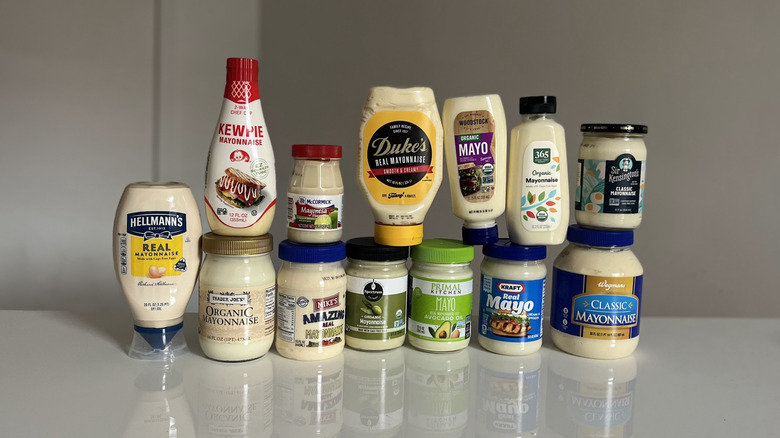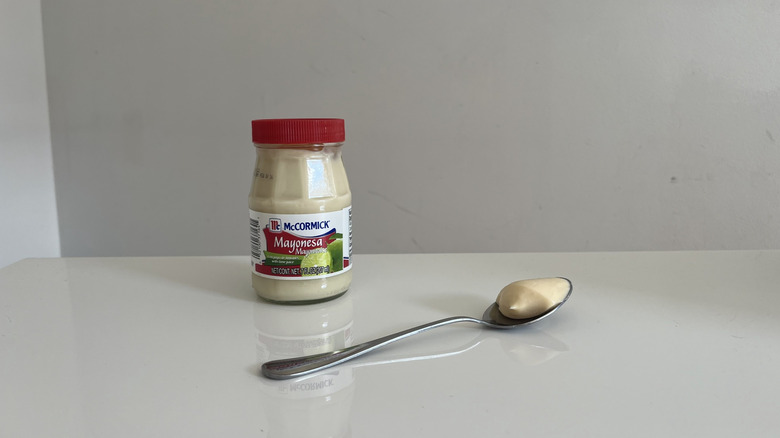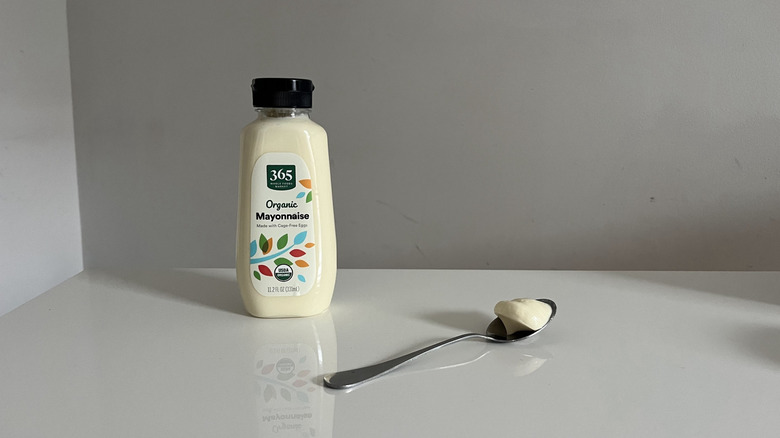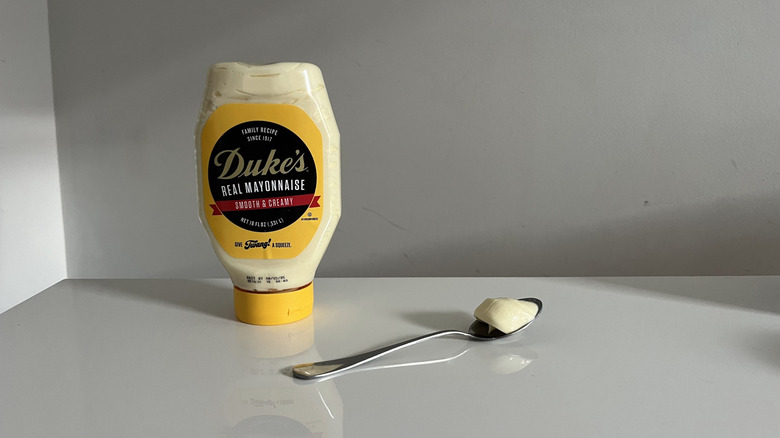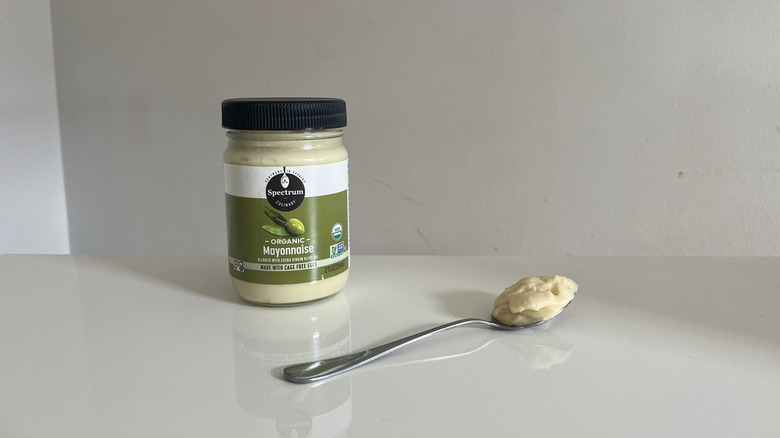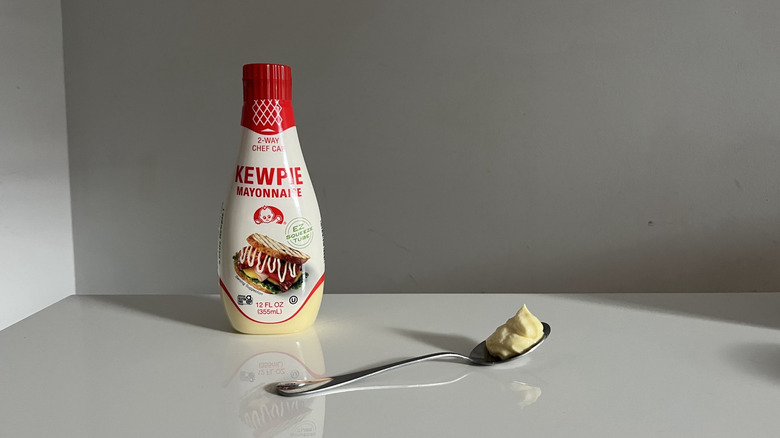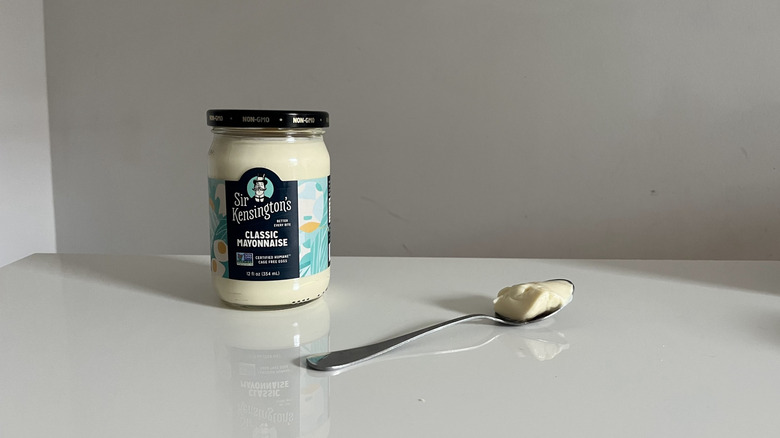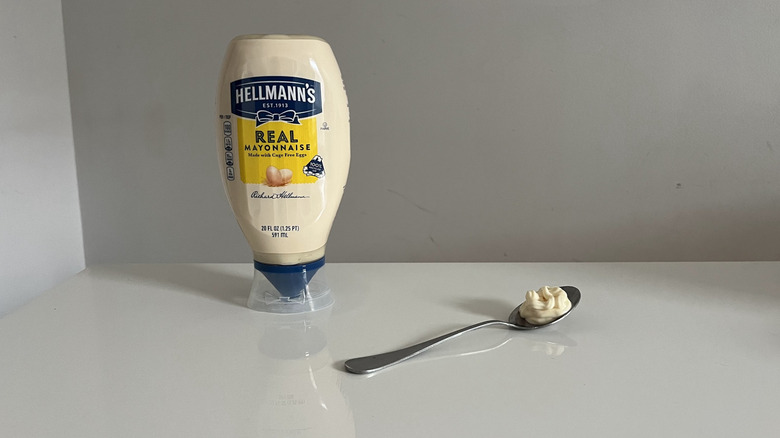13 Store-Bought Mayonnaise Brands, Ranked Worst To Best
We may receive a commission on purchases made from links.
Mayonnaise might seem like one of those condiments you never really think about. The egg-based spread simply does its job on sandwiches and in potato salads; quietly binding together tuna and chicken salads across the country. However, if you've run out and replaced your usual jar with whatever was on sale, you know not all mayonnaises are created equal. The right mayo can transform a BLT, while the wrong one will send your egg salad into a death spiral.
I gathered 13 brands to find out which mayonnaise truly reigns supreme, ranging from basic grocery staples to fancier jars that promise "real" ingredients and artisanal flair. Some are classics with century-old reputations; others are newcomers boasting organic oils and cage-free eggs. I tasted them side by side to search for a perfect balance of richness, acidity, and texture: the trifecta that separates greatness from mayo mediocrity. Whether you're a Hellmann's loyalist, a Kewpie evangelist, or a curious newcomer ready to branch out, you'll find something here to confirm (or challenge) your mayo loyalties.
13. Kraft
The first red flag is Kraft feeling a need to advertise on the jar that this is "real mayo." Methinks the mayonnaise doth protest too much. Kraft has been around since the early 20th century, first making processed cheese before branching into condiments, so you'd think they'd have perfected mayonnaise by now. Mayo should have a soft, creamy eggshell hue, but this jar's contents are suspiciously bright and unnaturally white.
There's plenty of fat, but very little of the yolky richness or subtle acidity that helps mayo taste like more than just an accessory condiment. The texture is oddly airy — almost whipped — which might seem appealing at first, but actually suggests corners were cut somewhere in processing. If you find yourself with a jar of this third-rate mayo, the lack of personality makes it a decent candidate for mixing with other ingredients to create more palatable dips or sauces, such as this two-sauce hack for chicken nuggets. Other than that, Kraft mayo is reliable only in its mediocrity. You're not even saving money by sacrificing quality: This jar is not particularly cheap, though it is easy to find in grocery stores across the country.
12. McCormick
While most mayos stick to vinegar and lemon for their acidic component, McCormick takes a slightly more daring approach by using lime juice alongside distilled vinegar. The idea is intriguing, and, in theory, the citrusy tang should brighten up the richness of the egg yolks and oil. In practice however, it's a too-subtle tweak that doesn't quite make the flavor leap you're hoping for. The mayo itself hits the visual mark perfectly: A creamy, off-white color which actually looks like what mayonnaise should look like.
Unfortunately, the texture feels a little overengineered. It's thick to the point of leaving a slick film on the tongue, which feels unnatural and almost industrial. The flavor is fatty, a touch heavy; and while the lime provides a hint of brightness, it doesn't cut through the richness in a way that excites. While that doesn't serve in most traditional applications of mayo, the thickness and subtle lime flavor do make this brand a good candidate for whipping up elote, a Mexican-style corn on the cob slathered in mayo, dusted with chili powder, and drizzled with lime juice. For all other applications, it's a fatty spread that would do in a pinch, but lacks the punch to elevate itself beyond average.
11. Mike's Amazing
Mike's Amazing Mayo arrives with another suspicious "real" claim on its label, making you wonder if the mayonnaise world is desperately insecure about authenticity. Despite the name promising marvels, this mayo lands somewhere between decent and dull. There's a noticeable acidic bite that helps balance the heaviness of egg yolks and vegetable oil, but it's largely a one-note performance. The egg flavor is almost absent and the dominant taste is neutral oil paired with a white vinegar without subtlety or complexity.
Texturally, however, there's a soft jiggle and a creamy spreadability that feels satisfying on bread or mixed in a salad dressing. Founded in the 2010s, Mike's has managed to make it into plenty of mainstream grocery stores. The brand is clearly trying to stake a claim as artisanal, but flavor-wise it's timid. The taste won't overpower, which might make it ideal for picky eaters, but it also doesn't reward palates looking for nuanced flavor. If you're layering a sandwich and want your condiments to behave, Mike's Amazing will behave. If you're hoping for an oomph of eggy, tangy brilliance though — you'll be left disappointed.
10. 365
365 Organic mayo is surprisingly affordable for a Whole Foods product, making it one of the more reasonable organic options on the market. It uses cage-free eggs and organic oils, which is a plus for anyone looking for a cleaner ingredient list. Mustard dominates the flavor however, which tends to overwhelm the subtle egginess that might otherwise be present. The acidity is strong, and the mustard notes make this mayonnaise a little too assertive for your average sandwich maker. While this could be a positive for people who enjoy bold, mustard-forward flavors, it limits the versatility of the mayo in recipes that require a milder base, such as aioli or lighter dipping sauces.
On the positive side, the texture is excellent. The mayo is thick enough to hold its shape when squeezed from a jar, providing good coverage on sandwiches, salads, or other dishes. It spreads easily without becoming runny, which is a reliable sign of quality in mayonnaise. Despite its flaws, 365 remains a solid choice for those who prefer a more assertive, mustard-heavy flavor in their mayo; especially given its relatively low price point and organic ingredients. That said, it may not be the best fit for lovers of a more neutral, traditional mayo.
9. Duke's
I'm a bit nervous to rank this product so low because I know that Duke's Mayonnaise has a cult following in the South. Created in 1917 by Eugenia Duke in Greenville, South Carolina, the spread became a regional favorite thanks to its creamy texture and lack of added sugar — a point of pride that still distinguishes the mayo from other major brands. Expectations were high with that legacy in mind, but satisfaction? Not so much. The flavor is relatively neutral; offering smooth fattiness without much of the distinctive egginess or acidity that makes other mayonnaises stand out.
The texture is thick and stable and spreads easily without breaking down; making it a dependable choice for sandwiches and sauces. Duke's adds richness and moisture, but doesn't bring much in the way of complexity. Those who grew up with the brand may find comfort in its familiarity, though it feels a little lackluster in a lineup including mayos with more distinctive tang or nuanced depth. For many, that's exactly the point. For others, it might feel like a missed opportunity for something a bit brighter.
8. Spectrum
Spectrum Organic mayonnaise takes an interesting approach by blending olive oil and soy oil, presumably in hopes of achieving a slightly more complex flavor profile. On paper, this sounds promising: The mild fruitiness of olive oil could lend depth to what might otherwise be a very plain condiment. In practice, the result is understated to the point of boredom. The olive oil's presence is too subtle, and the overall flavor lacks the acidity needed to balance the richness of the oil and egg, resulting in a mayo that feels heavy and one-dimensional.
The texture is where Spectrum struggles most. Instead of the smooth, glossy appearance typical of higher-quality mayonnaise, it appears uneven when spooned out of the jar; forming small clumps rather than a consistent cream. The mixture spreads well enough, but visually it's not particularly appetizing. On the positive side, Spectrum's ingredient list is clean, and the use of organic oils will appeal to anyone focused on sustainability and simple formulations.
7. Wegmans
If you live on the East Coast, you already know that Wegmans is one of America's most beloved grocery stores; inspiring a level of devotion most grocery chains can only dream of. This comes with good reason: Wegmans store-brand products are generally high quality and thoughtfully made; often rivaling or surpassing name-brand counterparts. While the store's mayonnaise is decent, it doesn't quite rise above the "very good" category. It's got the right look: a creamy, pale off-white color signaling classic mayo and a smooth, easily spreadable texture that doesn't feel too oily.
That said, the subtle richness of egg yolk and the bright lift of acidity that define great mayonnaise are both muted here; leaving the final product a bit diluted. It's not bad ... just unmemorable. Still, for the price (especially considering the generous jar size), Wegmans mayo delivers excellent value and broad appeal. It's the sort of mayonnaise that will never offend anyone, and it's a fine choice if you want something that blends in rather than stands out.
6. Primal Kitchen
In concept, presentation, and price, Primal Kitchen mayonnaise lands firmly in the premium category. Marketed to a health-conscious crowd, it's made with avocado oil instead of the standard canola or soy oils; giving it a richer and more distinctive flavor. Avocado oil features a mild nuttiness and a subtle grassy flavor that comes through in the finished product, which can be appealing or distracting depending on your expectations. Those used to the neutral taste of traditional mayonnaise might find Primal Kitchen's version a little unusual.
On the positive side: The profile is noticeably eggier than most competitors, with a creamy, dense texture that feels substantial. The acidity is a bit too restrained however, which leaves the overall flavor somewhat flat and overly fatty. A little more brightness would go a long way offsetting the richness of both the eggs and the avocado oil. Still, it's a clean, high-quality mayo made with wholesome ingredients and no artificial additives, so it has clear appeal for anyone avoiding seed oils or ultra-processed condiments.
5. Kewpie
With its iconic baby logo waving at you from the front of the bottle, Kewpie definitely wins for cutest branding. This Japanese mayonnaise has achieved near-cult status both in Japan and internationally for its creamy texture, deep umami flavor, and iconic squeeze bottle. Unlike traditional Western mayonnaise which relies solely on distilled vinegar, Kewpie incorporates a blend — including red wine and rice vinegar — along with a touch of yeast extract. The result is a mayo that's slightly sweeter, richer, and more complex than the standard version.
The mayo boasts an exceptionally smooth and custard-like texture, featuring less egg-focused flavor and more savoriness. This pairs exceptionally well with bold Japanese dishes like okonomiyaki, takoyaki, and yakisoba; providing creamy contrast to salty, umami-heavy sauces. While this brand can absolutely be used in Western applications, it's not quite a one-to-one substitute for American mayo. For the best homemade spicy mayo, reach for the sriracha bottle and combine with Kewpie; an ideal choice for adding depth to bold sauces.
4. Sir Kensington's
The monocled gentleman on the label says it all: Sir Kensington's Mayonnaise positions itself as a more refined option for your condiment shelf. This spread is made with sunflower oil and cage-free eggs; ingredients that set a high bar and immediately convey quality. The result is mayonnaise with a distinctly egg-forward flavor; probably the most pronounced of any on this list. Lemon juice provides the main source of acidity, and a small amount of sugar rounds out the flavor profile. Together, these form a mayo that feels richer and more indulgent than average. The sunflower oil lends a smooth, almost buttery quality with a richness that could be balanced with a touch more acidity.
Still, it's clear from the first taste that Sir Kensington's prioritizes ingredient integrity. The texture is thick and silky; spreading beautifully and holding up well. It's particularly good in small, deliberate applications, such as sandwiches with sharp greens, or herby egg salads where you want the mayo to stand out rather than disappear. While Kensington's may be one of the more expensive options, it's also one of the most luxurious. This is ideal for those who prefer their condiments on the richer side — no pun intended.
3. Trader Joe's
Trader Joe's Organic mayonnaise is a standout example of how the California-based retailer offers excellent products at unexpectedly reasonable prices. Entirely organic and available for far less than comparable competitors, it's a welcome surprise in 2025's grocery landscape. The flavor achieves an impressive equilibrium between richness and brightness, thanks to the inclusion of both distilled vinegar and lemon juice. Together, they provide a lively acidity that keeps the mayo from feeling too heavy while still preserving its creamy depth.
The egg flavor is present but not dominant, lending subtle warmth to complement the tangy undertones. The mixture's off-white color looks appetizingly natural, and the texture hits all the right marks: thick enough to hold its shape, but soft enough to spread easily. It has a pleasant, slight jiggle; signaling freshness and good emulsification.
In use, Trader Joe's is restrained enough for spreading mayo on both slices of bread in a BLT, but lively enough for coleslaw. It's an easy recommendation for anyone looking for an affordable, organic mayo that doesn't sacrifice quality or taste.
2. Woodstock
Woodstock Organic mayonnaise may not have the brand recognition of the bigger players, but it deserves serious attention. Made with familiar, straightforward ingredients (soybean oil, egg yolks, and distilled white vinegar), the brand adds a few thoughtful touches to set themselves apart. A splash of lemon juice enhances the acidity while a hint of white mustard lends gentle spice and earthiness; granting the mayo a natural, balanced depth of flavor.
The spread's color is ideal for a classic mayo: creamy off-white with a subtle glossy sheen. Its aroma has a pleasant tang — lightly vinegary with a touch of citrus — which gives the impression of something freshly made rather than overly processed. Texture-wise it's smooth and cohesive; maintaining shape without the gelatinous thickness that can make store-bought mayonnaise feel artificial. Woodstock is also attractively priced as a fully-organic option, making this condiment a smart middle-ground choice for anyone who wants quality ingredients without paying premium prices.
1. Hellmann's
Few will be surprised to find Hellmann's at the top of this ranking. Ever since Richard Hellmann began peddling his product over a century ago in New York City, the brand has set the definition of mayonnaise. Julia Child herself couldn't hide a love for this iconic mayo, which is high praise in the condiment world. Hellmann's juggles richness, tang, and smoothness with remarkable precision. The flavor showcases egg yolk creaminess tempered by just enough acidity from vinegar to keep the taste lively; plus a bit of lemon juice to add citrusy brightness.
The texture is another strong point: thick yet perfectly spreadable, with a creamy consistency both indulgent and reliable. Its deep off-white color looks appetizingly natural, and every element feels in proportion — both likely reasons why Hellmann's has become the standard against which others are measured. Even the company's more eccentric ventures (there was once a Hellmann's mayonnaise cologne, if you can believe it) haven't dented the brand's reputation for quality. Hellmann's is a classic for a reason, and it still reigns supreme.
Methodology
To keep things fair and practical, I limited the taste test to popular mayonnaise brands that are widely available in grocery stores across the United States. That meant skipping the ultra-niche artisanal options you have to order online, and focusing on jars you can actually toss into your cart at the supermarket.
Every mayo was evaluated in two ways: First on its own, straight from the jar; then spread on a plain piece of wheat bread. Tasting each offering solo allowed me to focus on key qualities such as flavor balance (the relationship between fat, egg, and acid), texture (creamy vs. oily or gelatinous), and color (ideally a soft off-white; not pure snow). Testing the spreads on wheat provided a real-world context for how they perform in the environment where mayo most often lives: between slices of bread.
I used clean utensils, kept samples refrigerated and fresh, and tasted multiple times to ensure consistent impressions. The result is a thorough, hands-on comparison designed to find the mayonnaise most worthy of your next sandwich.
